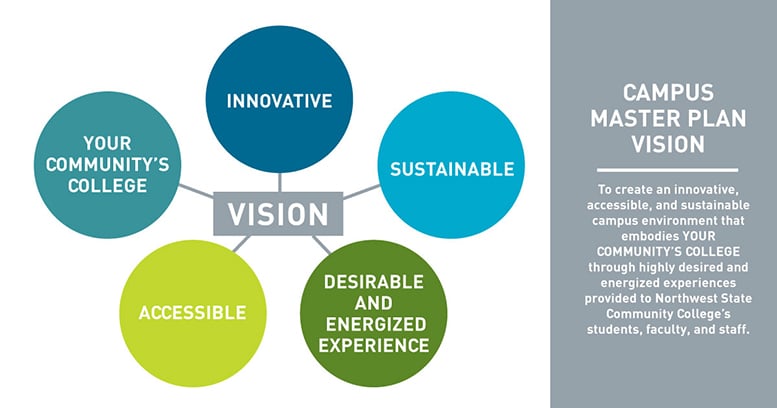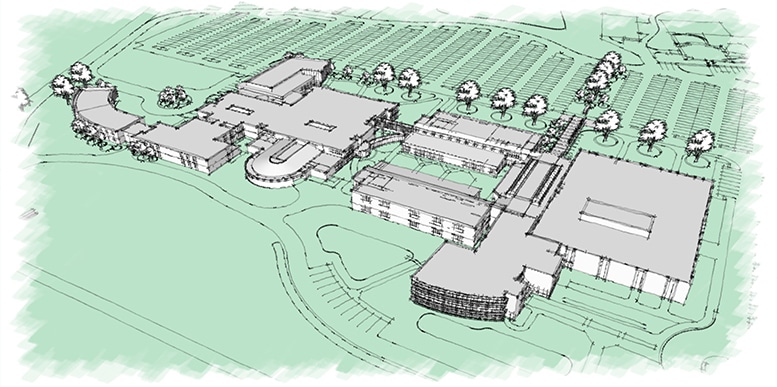Community colleges must look beyond the near term to address the converging challenges of declining enrollments and great economic uncertainty. Another pressing challenge is successfully integrating the hybrid on-campus/offline learning model that’s bloomed in the pandemic’s wake into campus life.

As planning committees struggle with these challenges, they must address what new types of physical facilities are needed to support their strategic objectives. How will facilities be maintained? What new types of facilities are needed to meet the evolving community college landscape? How will the community college ensure that it’s going to have the resources needed to build or retrofit the new facilities that can keep it competitive?
Planning a modernization of facilities that can meet the evolving student populations and expectations is an immediate need and a long-term process.
“Community colleges will continue to grapple with the fallout from the pandemic, changing student population, and aging facilities for the next five to ten years. We must sharpen our value proposition to remain competitive in the educational marketplace,” says Todd Hernandez, president of Northwest State Community College in Ohio.
Adapting to meet the needs of communities
Many students considering community colleges experienced more modern high school classrooms and learning labs than what they see at two-year institutions. In a competitive environment for students, community colleges need facilities that impress students. Community colleges should consider upgrading and increasing space for:
- Adaptable facilities for practical learning where students learn by doing to gain proficiency in needed skills. Even as enrollment declines overall at community colleges, enrollment in allied health programs, such as nursing, dentistry, physical and occupational therapy; and skilled trades programs, including HVAC, electrical, plumbing and welding, is increasing. Planning committees should identify its popular high-skilled programs and what high-skilled jobs are in demand in the local area to determine what types of practical learning labs to add to its master plan.
- “Zoom rooms” or on-site quiet spaces where students can also take advantage of online learning as part of a hybrid learning delivery model. Students need small, quiet rooms where they can attend an online class on campus as easily as their in-person class. A “Zoom room” should comfortably contain one to two students. The hybrid model didn’t exist until a couple of years ago. Consequently, planning committees need to make some assumptions about how much space should be retrofitted into small, online study rooms based on the current percentage of students enrolled in both off- and online classes. In the future, community colleges can look at actual demand and utilization of Zoom rooms to refine their ratio of how many are needed to fit its student population.
- Social spaces where students can go between classes, creating a quasi-student center. Including a combination of seating alternatives, from soft couches and community tables to high cafe counters creates a mixed-used space where students can socialize or get some work done. It can also host light dining facilities, such as a coffee/tea counter with a microwave and vending machines offering fresh food. A well-thought-out social space can entice students to stay on campus, even when they need something to eat. Adding a source of natural light to the social space works as a magnet drawing students into the space and elevating the entire on-campus experience.
- Physical activity facilities to provide students opportunities to address their overall wellness. Some community colleges added athletic programs, such as baseball or track, which require specific facilities. Another option is creating workout rooms with exercise equipment or a track open to all students.
Community colleges that add and modernize these types of spaces position themselves to attract more students and retain faculty and staff.

Revisiting strategic and master plans to reflect new realities
Colleges face many challenges to updating aging facilities and building new ones. Today’s shrinking enrollments and state budgets make it more difficult to launch new capital projects. The starting point is reviewing the college’s strategic plan to ensure it aligns with its role in the changing atmosphere of secondary education. Important questions the review committee should ask include:
- Do any of the pillars in the strategic plan address the college’s critical function of preparing students who are ready to join high-demand, high-skilled jobs?
- Who are the champions of these pillars to ensure they will lead to a positive impact for students and the institution?
- How can the quality of training facilities be improved to ensure the institution is making the right strategic moves to meet this objective?
The next step for community colleges is to look at their master plan. If they do not have a master plan, they need to create one. The master plan is an essential roadmap to increase the likelihood the community college aligns its physical campus with its strategic objectives. When taking stock of the master plan, some key questions to ask are:
- What are the “rising star” academic programs and how do existing physical facilities enable these programs to grow?
- How are existing facilities used? Which facilities can be better utilized by scheduling more frequent classes and labs?
- What academic programs should be considered for sunsetting, such as programs that are costly to offer or have low enrollment?
- Is there an active program to create partnerships with local employers who can donate equipment, funds, and mentors? “Local businesses recognize the value in donating equipment and providing mentoring to our students; they’re investing in their future employees,” says Jennifer Fehnrich, director of development at Ohio’s Terra State Community College.
The answers to these questions provide insight on how to best optimize existing campus assets and find outside resources to improve practical learning facilities and programs.
Opportunities for community colleges
Community colleges are poised to become the high-value educational choice as students look to earn a practical education quickly and without taking on too much debt. The community colleges nimble enough to evolve their strategic and master plans will be in the best position to attract students, employer and industry support, and faculty if those plans include a roadmap to providing the spaces on campus that meet the changing expectations of these stakeholders.
* * *

Tom Sens is a client leader specializing in higher education at BHDP Architecture with more than 30 years of experience working with higher education clients. His experience includes visioning, programming and design for new construction and renovation projects, including libraries, classrooms, collaborative learning environments, and research and teaching laboratories.





